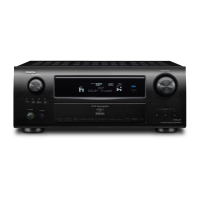Getting Started Connections Settings Playback Remote ControlMulti-zone Troubleshooting Specifications
ENGLISH
Explanation of Terms
DTS 96/24
DTS 96/24 is a digital audio format enabling high sound quality
playback in 5.1-channels with a sampling frequency of 96 kHz and 24
bit quantization on DVD-Video.
Manufactured under license under U.S. Patent #’s: 5,451,942;
5,956,674; 5,974,380; 5,978,762; 6,226,616; 6,487,535; 7,212,872;
7,333,929; 7,392,195; 7,272,567 & other U.S. and worldwide patents
issued & pending. DTS is a registered trademark and the DTS logos,
Symbol, DTS-HD and DTS-HD Master Audio are trademarks of DTS,
Inc. © 1996-2008 DTS, Inc. All Rights Reserved.
DTS Express
DTS Express is an audio format supporting low bit rates (max. 5.1-
channels, 24 to 256 kbps).
Audyssey MultEQ
®
XT
Audyssey MultEQ XT is a room equalization solution that calibrates any
audio system so that it can achieve optimum performance for every
listener in a large listening area. Based on several room measurements,
MultEQ XT calculates an equalization solution that corrects for both
time and frequency response problems in the listening area and also
performs a fully automated surround system setup.
Audyssey Dynamic EQ™
Audyssey Dynamic EQ solves the problem of deteriorating sound
quality as volume is decreased by taking into account human
perception and room acoustics. Audyssey Dynamic EQ works in
tandem with Audyssey MultEQ XT to provide well-balanced sound for
every listener at any volume level.
Audyssey Dynamic Volume™
Audyssey Dynamic Volume solves the problem of large variations in
volume level between television programs, commercials, and between
the soft and loud passages of movies.
Audyssey Dynamic EQ is integrated into Dynamic Volume so that as
the playback volume is adjusted automatically, the perceived bass
response, tonal balance, surround impression, and dialog clarity
remain the same.
Audyssey
Audyssey Dynamic Surround Expansion™ (DSX)
Realistic reproduction of sound relies on the ability of audio systems
to match human hearing performance. Three key requirements are:
(i) frequency response; (2) dynamic range; and (3) accurate spatial
reproduction. The requirements for frequency response have already
been surpassed with sampling rates that exceed human hearing. The
dynamic range limits of human perception have also been met with
current digital audio systems operating capable of signal to noise ratios
that approach 120 dB. Accurate spatial sound rendering, however, has
not yet reached the limits of perception as human perception relies on
the combination of sounds arriving from many more directions than
what 5.1 surround sound systems provide. Audyssey DSX technology
was developed to overcome the spatial sound rendering limitations
faced by 5.1 surround sound formats.
The ITU 5.1 channel standard recommends three front loudspeakers
and two rear loudspeakers. The Left (L) and Right (R) front
loudspeakers should be placed at ±30° relative to the central listening
position. The Center (C) loudspeaker should be at 0° and the surround
loudspeakers (SL, SR) should be placed between 100° and 120°. All
loudspeakers must be equidistant from the center listening position or
compensated with time delay if that is not possible. A separate low-
frequency effects (LFE) channel is used to reproduce additional bass
content from the subwoofer.
There are certain things that 5.1 surround sound systems do well
compared to 2-channel stereo. For example, it is possible to move
sounds across the front seamlessly. It is also possible to create
ambience behind the listener. But 5.1 channel surround systems do not
provide enough channels from which to render the required reflected
sound components for a seamless and enveloping soundstage.
Unfortunately, the additional two back surround channels in 7.1
systems are not in the right place to provide a significant perceptual
improvement.
Adding more channels to a surround system is not for special
effects. Accurate spatial sound reproduction requires rendering of
directional sound cues and non-directional ambient cues. Reflections
arriving after the direct sound play a critical role in the perception of
soundstage width and depth. To have the most impact, additional
surround channels should be used to control the direction, time of
arrival, and frequency response of the reflected sound to render an
expanded soundstage that reproduces sound with better localization
and envelopment than what 5.1 systems provide.
Information
DTS Surround
DTS Digital Surround
DTS Digital Surround is the standard digital surround format of DTS,
Inc., compatible with a sampling frequency of 44.1 or 48 kHz and up
to 5.1-channels of digital discrete surround sound.
DTS-ES™ Discrete 6.1
DTS-ES™ Discrete 6.1 is a 6.1-channel discrete digital audio format
adding a surround back (SB) channel to the DTS digital surround
sound.
Decoding of conventional 5.1-channel audio signals is also possible
according to the decoder.
DTS-ES™ Matrix 6.1
DTS-ES™ Matrix 6.1 is a 6.1-channel discrete digital audio format
inserting a surround back (SB) channel to the DTS digital surround
sound through matrix encoding. Decoding of conventional 5.1-channel
audio signals is also possible according to the decoder.
DTS-HD High Resolution Audio
DTS-HD High Resolution Audio is an improved version of the
conventional DTS, DTS-ES and DTS 96/24 signals formats, compatible
with sampling frequencies of 96 or 48 kHz and up to 7.1-channels
of discrete digital sound. High data bit rate performance provides
high quality sound. This format is fully compatible with conventional
products, including conventional DTS digital surround 5.1-channel
data.
DTS-HD Master Audio
DTS-HD Master Audio is DTS, Inc’s lossless audio format compatible
with up to 96 kHz/7.1-channels. The lossless audio coding technology
faithfully reproduces the sound of the studio master. It is fully
compatible with conventional products, including conventional DTS
digital surround 5.1-channel data.
DTS NEO:6™ Surround
DTS NEO:6™ is a matrix decoding technology for achieving 6.1-
channel surround playback with 2-channel sources. It includes “DTS
NEO:6 Cinema” suited for playing movies and “DTS NEO:6 Music”
suited for playing music.

